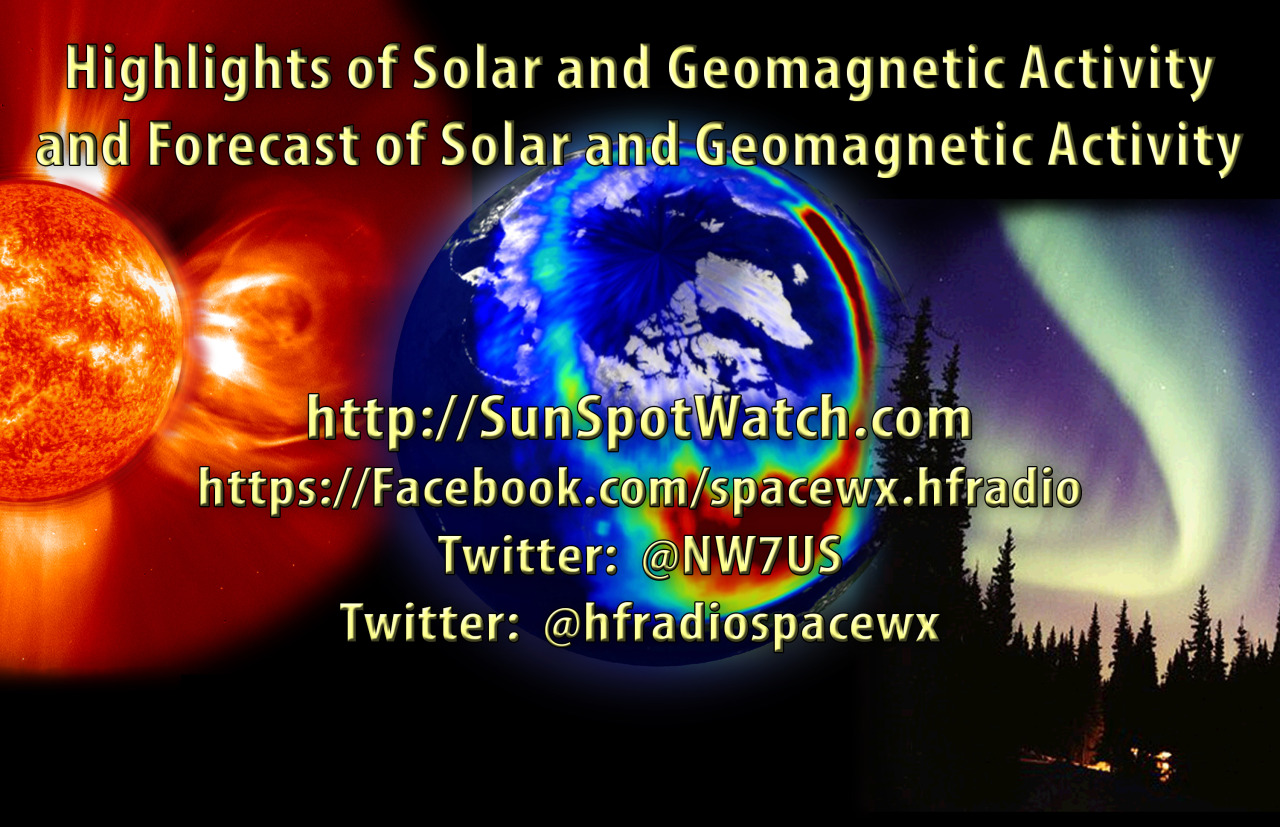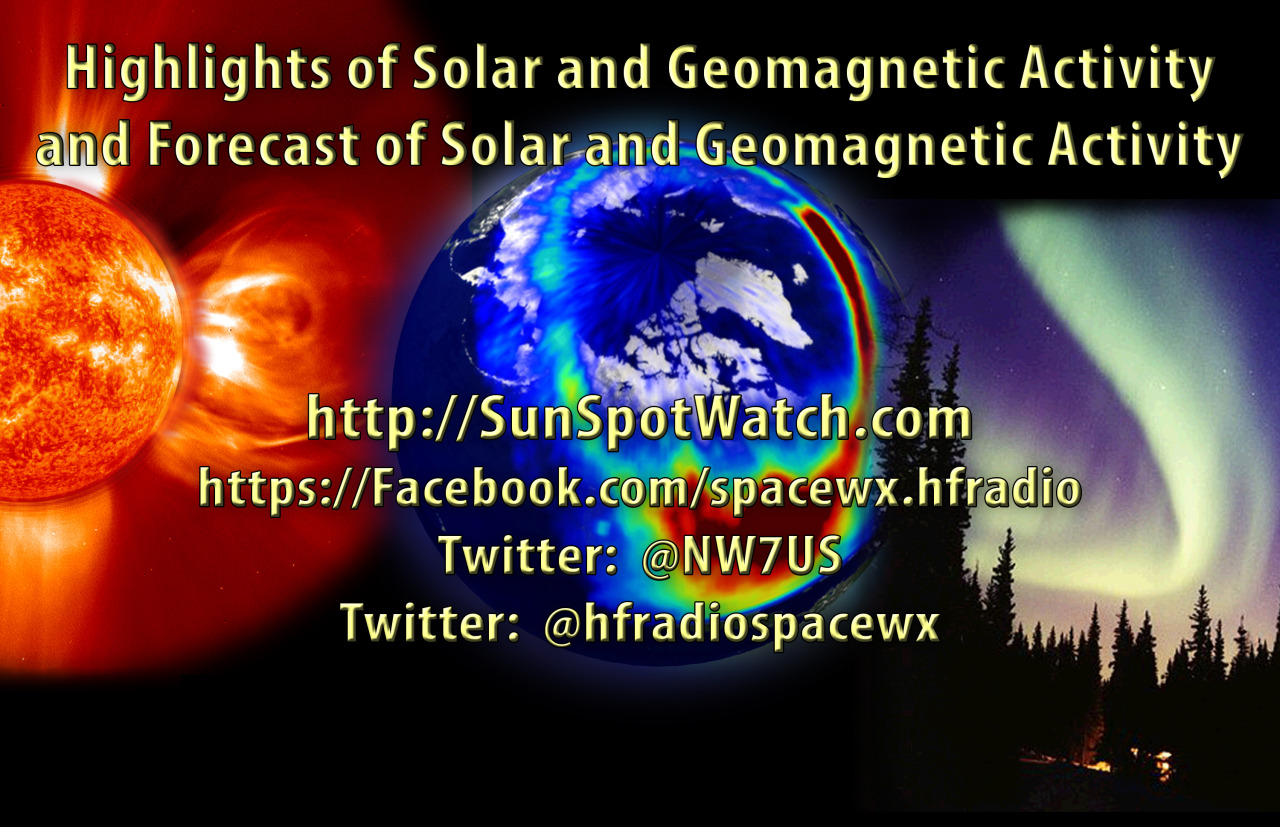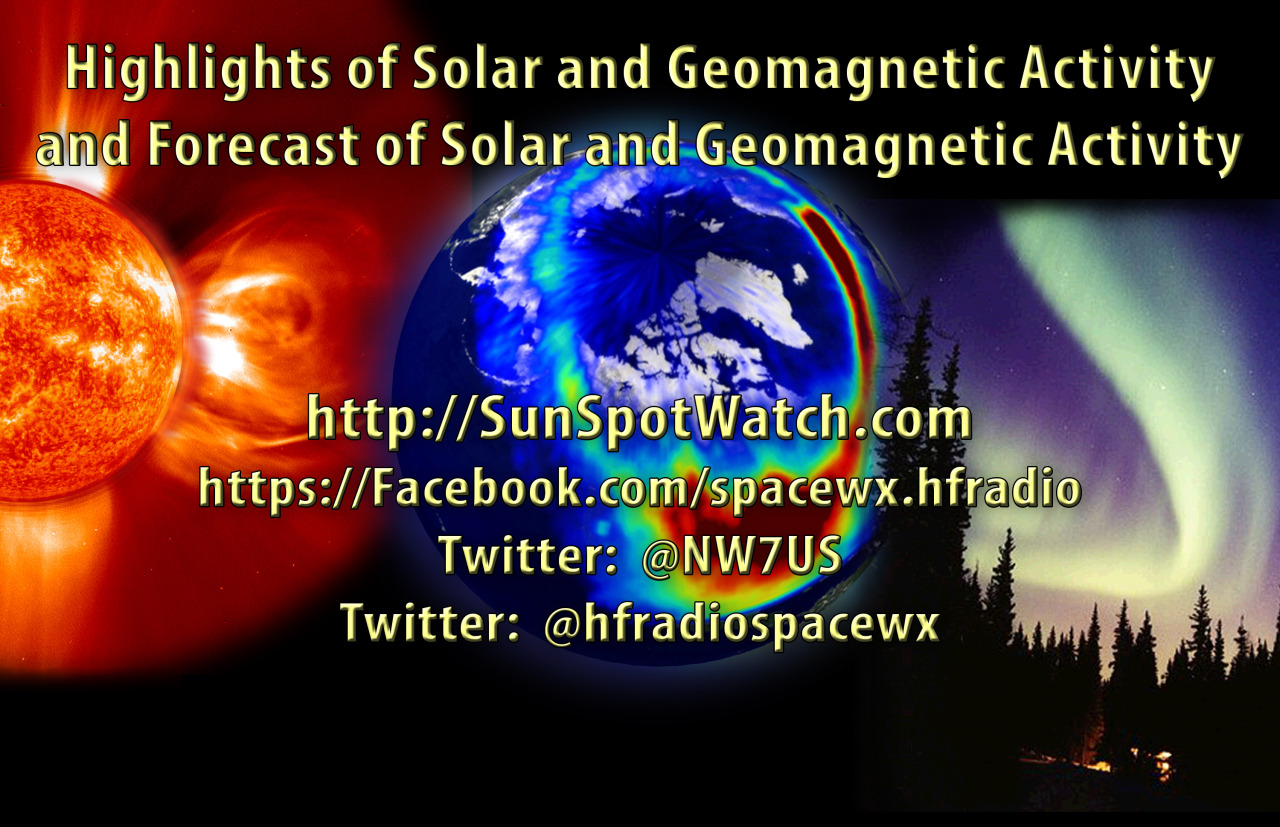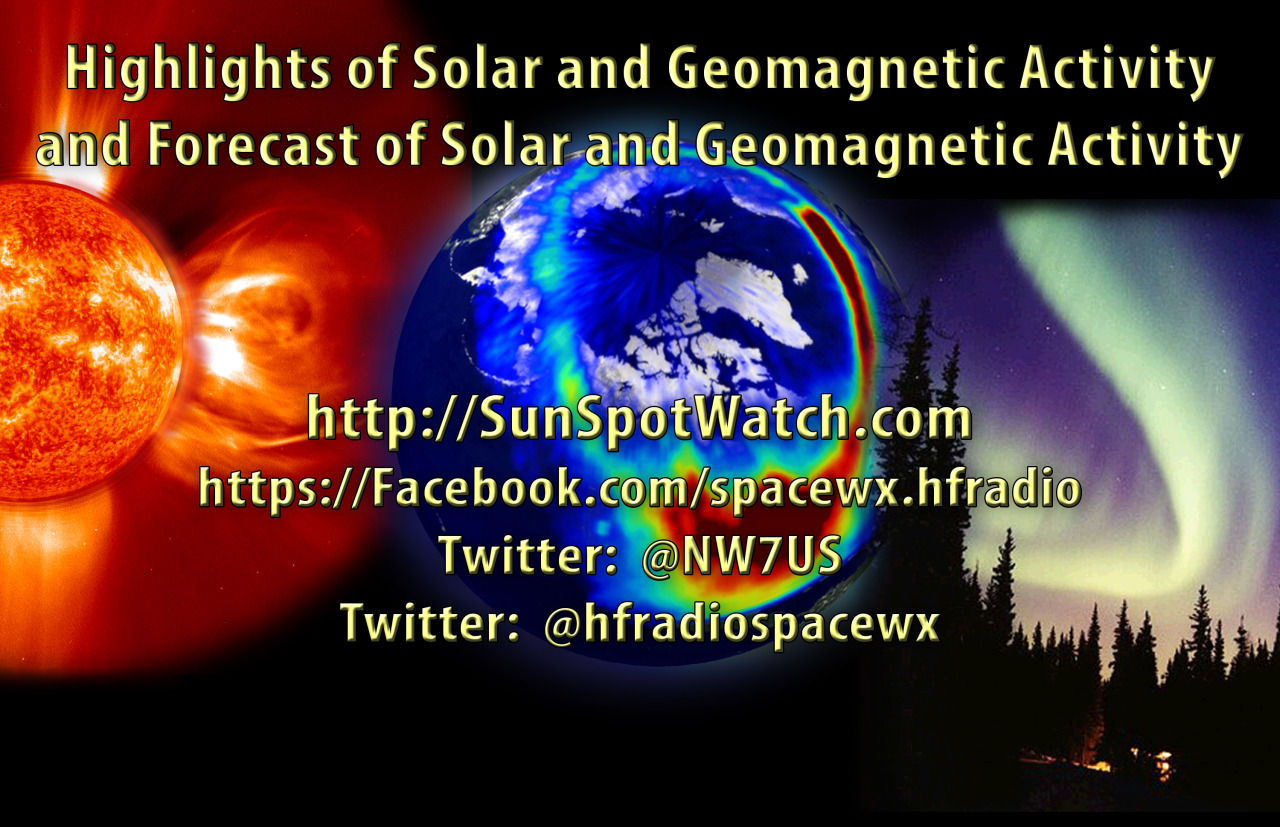Author Archive
 Weekly Propagation Summary – 2015 Dec 21 16:10 UTC
Weekly Propagation Summary – 2015 Dec 21 16:10 UTC
Here is this week’s space weather and geophysical report, issued 2015 Dec 21 0423 UTC.
Highlights of Solar and Geomagnetic Activity 14 – 20 December 2015
Solar activity was at low levels. The period was dominated by low to mid-level C-class flare activity from a number of active regions, the largest of which was a C6/1f flare at 16/0903 UTC from Region 2468 (S15, L=128, class/area=Dao/120 on 10 Dec). Region 2468 was the most productive region on the visible disk throughout the summary period, however, an unnumbered region behind the northeast limb produced multiple mid-level C-class flares within quick succession and caused a slow increase in the background GOES-15 x-ray flux late in the period.
Two asymmetrical full-halo coronal mass ejections (CMEs) were observed in SOHO/LASCO C2 coronagraph imagery on 16 Dec. The first CME was observed in C2 imagery beginning at 16/0924 UTC and was associated with the C6/1F flare mentioned above. The second CME, associated with a filament eruption, was first observed in coronagraph imagery at 16/1436 UTC. Both CMEs were determined to be Earth-directed and arrived at Earth late on 19 Dec. See the geomagnetic summary below for further information on this event.
No proton events were observed at geosynchronous orbit.
The greater than 2 MeV electron flux at geosynchronous orbit reached high levels on 14 Dec and 19 Dec with moderate levels observed throughout the remainder of the period.
Geomagnetic field activity reached active to G1 (Minor) geomagnetic storm levels late on 14 Dec and early on 15 Dec due to the influence of a corotating interaction region followed by the onset of a negative polarity coronal hole high speed stream (CH HSS). Isolated active field conditions were observed early on 16 Dec and again late on 17 Dec due to weak substorming. The CMEs from 16 Dec presumably merged in the interplanetary medium and impacted the Earth at 19/1528 UTC. During the passage of the interplanetary shock, solar wind parameters aboard the ACE spacecraft became suddenly enhanced. Total field strength values initially increased from 5 nT to 17 nT and the Bz component went strongly southward shortly after the initial shock passage. The prolonged period of southward magnetic field (-Bz) associated with the passage of the 16 Dec CMEs caused periods of active conditions late on 19 Dec and active to G2 (Moderate) geomagnetic storm levels on 20 Dec. G2 storm conditions were observed between 20/0300-0600 UTC and 20/1500-2359 UTC.
Forecast of Solar and Geomagnetic Activity 21 December – 16 January 2016
Solar activity is expected to be low throughout the period with a chance for M-class flares (R1-R2 (Minor-Moderate) Radio Blackouts) on 21 Dec through 03 Jan to the increased flare activity from an unnumbered region behind the east limb.
No proton events are expected at geosynchronous orbit.
The greater than 2 MeV electron flux at geosynchronous orbit is expected to be at normal levels on 21-27 Dec, moderate levels on 31 Dec-02 Jan, and 14-16 Jan. High flux levels are expected on 28-30 Dec and 03-13 Jan.
Geomagnetic field activity is expected to be at active to G2 (Moderate) geomagnetic storm levels early on 21 Dec due to the waning effects of the 16 Dec coronal mass ejections. G1 (Minor) geomagnetic storms are likely on 02, 06, and 10 Jan due to the influence of recurrent coronal hole high speed streams.
Don’t forget to visit our live space weather and radio propagation web site, at: http://SunSpotWatch.com/
Live Aurora mapping is at http://aurora.sunspotwatch.com/
If you are on Twitter, please follow these two users: + https://Twitter.com/NW7US + https://Twitter.com/hfradiospacewx
Get the space weather and radio propagation self-study course, today. Visit http://nw7us.us/swc for the latest sale and for more information!
Check out the stunning view of our Sun in action, as seen during the last five years with the Solar Dynamics Observatory (SDO): https://www.youtube.com/watch?v=zXN-MdoGM9g
We’re on Facebook: http://NW7US.us/swhfr
 Get Ready: Month-long Special Event for SKCC, the 2016 K3Y Celebration
Get Ready: Month-long Special Event for SKCC, the 2016 K3Y Celebration
Are you ready for the annual, month-long special event by the Straight Key Century Club (SKCC)? The SKCC Group membership is free, and celebrates the longest tradition of amateur radio: Morse code. But, not just any Morse code. The manual creation of Morse code by “straight” keys means no electronic origin, only mechanical. This is a month-long event, during January 2016, modelled after the ARRL Straight Key Night.
Here’s a video that I made showing my activity as the control operator of the special event station, K3Y/0, during one of the many shifts during January (2015). K3Y is the special event callsign of the Straight Key Century Club (SKCC). The special event operates each January. I’ll be doing this again, this coming month, January of 2016.
K3Y, the Straight Key Century Club’s annual January celebration, commemorates the club’s founding in 2006 following the American Radio Relay League’s Straight Key Night. A small group of participants wanted to extend the fun of SKN throughout the year. The SKCC is the result.
For the first three years, the club’s founders used K1Y, K2A, and K3Y as the celebration’s special-event calls. But someone cleverly noticed that a 3 is nothing more than a backwards, curvaceous E. This “KEY” event has operated under the K3Y call ever since.
The on-air party is open to members and non-members alike. It runs from 0000 UTC Jan. 2 through 2359 UTC Jan. 31. It’s a great time to introduce others to the joys of hand-crafted Morse code using straight keys, bugs, and side swipers.
This year, January 2016, we’ll be fielding K3Y operators in each of the 10 US call areas, plus KH6, KL7 and KP4, along with specially scheduled stations in each of six IARU continental regions. Your QSOs with event operators in all these 19 areas will be tabulated in the Statistics section and can be confirmed with a K3Y QSL card and Sweep Certificate.
+ The SKCC website is at http://skccgroup.com
+ The K3Y special event page is http://www.skccgroup.com/k3y/
73 de NW7US
dit dit
 Weekly Propagation Summary – 2015 Dec 14 16:10 UTC
Weekly Propagation Summary – 2015 Dec 14 16:10 UTC
Here is this week’s space weather and geophysical report, issued 2015 Dec 14 0121 UTC.
Highlights of Solar and Geomagnetic Activity 07 – 13 December 2015
Solar activity was at low levels and only C-class flare activity was observed throughout the period, the largest of which was a C7 flare at 12/1346 UTC from Region 2470 (N13, L=087, class/area=Dkc/270 on 13 Dec). No Earth-directed coronal mass ejections (CMEs) were observed this period.
No proton events were observed at geosynchronous orbit.
The greater than 2 MeV electron flux at geosynchronous orbit reached high levels every day of the summary period with a peak flux of 10,700 pfu observed at 09/1455 UTC.
Geomagnetic field activity was quiet to active levels on 07-08 Dec due to waning coronal hole high speed stream effects prior to the summary period. Unsettled to active field conditions were observed on 10-11 Dec, with an isolated period of G1 (Minor) geomagnetic storm levels observed between 10/0300-0600 UTC, due to the influence of a positive polarity coronal hole high speed stream.
Forecast of Solar and Geomagnetic Activity 14 December – 09 January 2016
Solar activity is expected to be at low levels throughout the outlook period with only C-class flare activity expected.
No proton events are expected at geosynchronous orbit.
The greater than 2 MeV electron flux at geosynchronous orbit is expected to reach high levels on 14-20, 29-31 Dec and 03-09 Jan. Low to moderate electron flux levels are expected throughout the remainder of the period.
Geomagnetic field activity is likely to reach G1 (Minor) geomagnetic storm levels on 16 Dec and 06 Jan due to the influence of recurrent coronal hole high speed streams. Active field conditions are likely on 15, 17-18, 27-28 Dec and 01, 03-04, 07-08 Dec due to coronal hole high speed stream effects. Quiet to unsettled levels are expected for the remainder of the period.
Don’t forget to visit our live space weather and radio propagation web site, at: http://SunSpotWatch.com/
Live Aurora mapping is at http://aurora.sunspotwatch.com/
If you are on Twitter, please follow these two users: + https://Twitter.com/NW7US + https://Twitter.com/hfradiospacewx
Get the space weather and radio propagation self-study course, today. Visit http://nw7us.us/swc for the latest sale and for more information!
Check out the stunning view of our Sun in action, as seen during the last five years with the Solar Dynamics Observatory (SDO): https://www.youtube.com/watch?v=zXN-MdoGM9g
We’re on Facebook: http://NW7US.us/swhfr
 Weekly Propagation Summary – 2015 Dec 07 16:10 UTC
Weekly Propagation Summary – 2015 Dec 07 16:10 UTC
Here is this week’s space weather and geophysical report, issued 2015 Dec 07 0214 UTC.
Highlights of Solar and Geomagnetic Activity 30 November – 06 December 2015
Solar activity was at low levels. Regions 2458 (N10, L=356, class/area Dao/160 on 24 Nov), 2462 (N09, L=216, class/area Hax/40 on 04 Dec), 2463 (S11, L=205, class/area Dao/130 on 05 Dec) and 2464 (S12, L=189, class/area Axx/10 on 05 Dec) each produced C-class flares. The largest event of the period was a C4/Sf at 1702 UTC on 04 December. No Earth-directed coronal mass ejections were observed during the period.
No proton events were observed at geosynchronous orbit.
The greater than 2 MeV electron flux at geosynchronous orbit was normal levels on 30 November and reached moderate levels on 01 December. High levels were observed from 02-04 December before returning to moderate levels for the remainder of the period.
Geomagnetic field activity was quiet to active with an isolated minor storm period from 0600-0900 UTC on 30 November due to effects from a positive polarity coronal hole high speed stream (CH HSS). Quiet to active levels were observed on 01 December as HSS influence continued. Predominately quiet conditions were observed from 02-04 December with some unsettled periods on 02 and 04 December. Quiet to active levels returned on 05 December due to effects from a co-rotating interaction region (CIR) ahead of a second positive polarity CH HSS. Unsettled to active conditions dominated 06 December with an isolated minor storm period observed from 0900-1200 UTC.
Forecast of Solar and Geomagnetic Activity 07 December – 02 January 2016
Solar activity is expected to be at very low to low levels throughout the forecast period.
No proton events are expected at geosynchronous orbit.
The greater than 2 MeV electron flux at geosynchronous orbit is expected to be at normal to moderate levels for the majority of the period with high levels likely on 08-09 December, 11-15 December and 29-31 December following anticipated recurrent CH HSS events.
Geomagnetic field activity is expected to reach minor storm levels on 07 and 08 December due to continued effects from a positive polarity CH HSS. Predominately unsettled to active conditions are expected to from 09-13 December with minor storm periods possible as HSS effects persist. Mostly quiet levels are expected from 14-26 December. Quiet to active conditions are likely on 27 and 28 December due effects from a second recurrent CH HSS followed by quiet to unsettled conditions on 29 December as influence subsides. Quiet conditions are expected on 30-31 December. Unsettled to active conditions are expected on 01 January with minor storm levels likely on 02 January as a third recurrent CH HSS moves into a geoeffective position.
Don’t forget to visit our live space weather and radio propagation web site, at: http://SunSpotWatch.com/
Live Aurora mapping is at http://aurora.sunspotwatch.com/
If you are on Twitter, please follow these two users: + https://Twitter.com/NW7US + https://Twitter.com/hfradiospacewx
Get the space weather and radio propagation self-study course, today. Visit http://nw7us.us/swc for the latest sale and for more information!
Check out the stunning view of our Sun in action, as seen during the last five years with the Solar Dynamics Observatory (SDO): https://www.youtube.com/watch?v=zXN-MdoGM9g
We’re on Facebook: http://NW7US.us/swhfr
 Weekly Propagation Summary – 2015 Nov 30 16:10 UTC
Weekly Propagation Summary – 2015 Nov 30 16:10 UTC
Here is this week’s space weather and geophysical report, issued 2015 Nov 30 0318 UTC.
Highlights of Solar and Geomagnetic Activity 23 – 29 November 2015
Solar activity was at very low levels with the exception of 23 and 25 November. Region 2454 (N14, L=121, class/area Dai/150 on 23 Nov) produced a few C-class events, the largest a C8/1f at 23/0228 UTC. Between 24/1130-1530 UTC, SDO/AIA 193 and 304 imagery observed a 20 degree long eruption, centered near S10W00, along a NW to SE oriented filament channel. No Earth-directed coronal mass ejections were observed during the period.
No proton events were observed at geosynchronous orbit.
The greater than 2 MeV electron flux at geosynchronous orbit reached moderate levels on 23-27 November but decreased to normal levels on 28-29 November.
Geomagnetic field activity was at quiet levels from 23-26 November. Mostly quiet levels were observed with a few isolated unsettled periods on 27-29 November and a single active period observed during the 29/2100-2400 UTC synoptic period due to prolonged negative Bz and slightly elevated solar wind speed.
Forecast of Solar and Geomagnetic Activity 30 November – 26 December 2015
Solar activity is expected to be at very low to low levels throughout the forecast period.
No proton events are expected at geosynchronous orbit.
The greater than 2 MeV electron flux at geosynchronous orbit is expected to be normal to moderate levels for the majority of the period with the exception of 03-05 December, 08-09 December and 11-15 December following several recurrent coronal hole high speed streams (CH HSS).
Geomagnetic field activity is expected to be unsettled to active on 30 November-02 December with minor storm periods expected on 01 December due to a recurrent positive polarity CH HSS. Quiet to unsettled levels are expected from 03-05 December. Isolated active periods are likely again on 06-07 December and 10 December as two subsequent positive polarity CH HSSs become geoeffective respectively. Quiet to unsettled conditions are expected to dominate the remainder of the forecast period.
Don’t forget to visit our live space weather and radio propagation web site, at: http://SunSpotWatch.com/
Live Aurora mapping is at http://aurora.sunspotwatch.com/
If you are on Twitter, please follow these two users: + https://Twitter.com/NW7US + https://Twitter.com/hfradiospacewx
Get the space weather and radio propagation self-study course, today. Visit http://nw7us.us/swc for the latest sale and for more information!
Check out the stunning view of our Sun in action, as seen during the last five years with the Solar Dynamics Observatory (SDO): https://www.youtube.com/watch?v=zXN-MdoGM9g
We’re on Facebook: http://NW7US.us/swhfr
 Weekly Propagation Summary – 2015 Nov 23 16:10 UTC
Weekly Propagation Summary – 2015 Nov 23 16:10 UTC
Here is this week’s space weather and geophysical report, issued 2015 Nov 23 0602 UTC.
Highlights of Solar and Geomagnetic Activity 16 – 22 November 2015
Solar activity was at very low to low levels over the period. Low levels occurred on 17-18 November and 21-22 November with Regions 2454 (N13, L=121, class/area Dac/130 on 22 Nov) and 2457 (N11, L=032, class/area Dsi/130 on 21 Nov) responsible for the C-class flare activity. The largest flares of the period were a pair of C5/Sf flares at 22/0210 UTC and 22/0538 UTC originating from Region 2454 which was in a growth phase after 21 November.
Two filament eruptions were observed at the beginning of the period that resulted in coronal mass ejections (CMEs). The first was an approximate 21 degree long filament, centered near S11W17, that lifted off around 15/2114 UTC. The second was an approximate 19 degree filament, centered near S26W24 that lifted off around 16/0114 UTC. Two CMEs were observed lifting off the SW limb in SOHO/LASCO C2 imagery at 15/2336 UTC and 16/0312 UTC, respectively. Analysis of these CMEs indicated a likely glancing blow early on 19 November. Later in the period, another filament eruption, centered near S20E10, occurred around 22/0600 UTC. An associated CME, observed in C2 imagery beginning at 22/0836 UTC, was mostly directed off the east limb. Subsequent analysis of this CME indicated a very low chance for a glancing blow.
No proton events were observed at geosynchronous orbit.
The greater than 2 MeV electron flux at geosynchronous orbit was at high levels on 16 November with a maximum flux of 3,129 pfu at 16/1525 UTC. Normal to moderate levels were observed from 17-22 November.
Geomagnetic field activity ranged from quiet to minor storm periods over the period. Solar wind conditions began the period near nominal levels with prolonged periods of southward Bz near -6 nT on 16 November. Subsequently, the geomagnetic field responded with unsettled to active periods. Quiet to unsettled levels were observed on 17 November. At approximately 17/1941 UTC, a solar sector boundary crossing to a mostly negative (towards) sector occurred followed by an increase in solar wind speed from 370 km/s to around 530 km/s by early on 19 November. An abrupt increase in total field from 6 nT to 12 nT occurred at 18/1925 UTC with a maximum southward deflection of the Bz component to -11 nT indicating the likely arrival of the CMEs from 15-16 November coupled with influences from a negative polarity coronal hole high speed stream (CH HSS). A geomagnetic sudden impulse (70 nT at the Wingst magnetometer) was observed at 18/2010 UTC. The geomagnetic field responded with (G1) minor storming late in the period on 18 November with quiet to active conditions on 19 November. Solar wind speed continued a slow decay over the rest of the period to background levels resulting in quiet to unsettled levels on 20-21 November and quiet conditions on 22 November.
Forecast of Solar and Geomagnetic Activity 23 November – 19 December 2015
Solar activity is expected to be low with a chance for M-class (R1-R2, Minor-Moderate) flares from 23-25 November due to flare potential from Region 2454. Very low to low levels are expected from 26 November through 07 December. There is also a chance for M-class flare activity from 08-19 December with the return of old Region 2454 (N13, L=121).
No proton events are expected at geosynchronous orbit.
The greater than 2 MeV electron flux at geosynchronous orbit is expected to be at normal to moderate levels with high levels likely from 26-28 November and again from 06-13 December due to CH HSS influence.
Geomagnetic field activity is expected to be at unsettled to active levels from 25-26 November and 05-12 December with (G1) minor storming likely on 06-07 December due to recurrent CH HSS activity.
Don’t forget to visit our live space weather and radio propagation web site, at: http://SunSpotWatch.com/
Live Aurora mapping is at http://aurora.sunspotwatch.com/
If you are on Twitter, please follow these two users: + https://Twitter.com/NW7US + https://Twitter.com/hfradiospacewx
Get the space weather and radio propagation self-study course, today. Visit http://nw7us.us/swc for the latest sale and for more information!
Check out the stunning view of our Sun in action, as seen during the last five years with the Solar Dynamics Observatory (SDO): https://www.youtube.com/watch?v=zXN-MdoGM9g
We’re on Facebook: http://NW7US.us/swhfr
 What is the big deal with amateur radio? What is it that you hear? (Part 1)
What is the big deal with amateur radio? What is it that you hear? (Part 1)
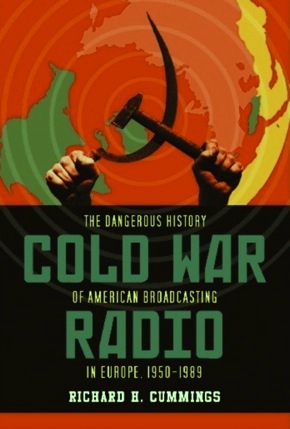
Shortwave radio has been a source for great sci-fi plots, spy intrigue novels, movies, and so on, since radio first became a “thing.” But, what is the big deal, really? What is it that amateur radio operators listen to?
In this video, I share some of the types of signals one might hear on the high frequencies (also known as shortwave or HF bands). This is the first video in an on-going series introducing amateur radio to the interested hobbyist, prepper, and informed citizen.
I often am asked by preppers, makers, and other hobbyists, who’ve not yet been introduced to the world of amateur radio and shortwave radio: “Just what do you amateur radio operators hear, on the amateur radio shortwave bands?”
To begin answering that question, I’ve taken a few moments on video, to share from my perspective, a bit about this shortwave radio thing:
Link to video: https://youtu.be/pIVesUzNP2U — please share with your non-ham friends.
From my shortwave website:
Shortwave Radio Listening — listen to the World on a radio, wherever you might be. Shortwave Radio is similar to the local AM Broadcast Band on Mediumwave (MW) that you can hear on a regular “AM Radio” receiver, except that shortwave signals travel globally, depending on the time of day, time of year, and space weather conditions.
The International Shortwave Broadcasters transmit their signals in various bands of shortwave radio spectrum, found in the 2.3 MHz to 30.0 MHz range. You might think that you need expensive equipment to receive these international broadcasts, but you don’t! Unlike new Satellite services, Shortwave Radio (which has been around since the beginning of the radio era) can work anywhere with very affordable radio equipment. All that you need to hear these signals from around the World is a radio which can receive frequencies in the shortwave bands. Such radios can be very affordable. Of course, you get what you pay for; if you find that this hobby sparks your interest, you might consider more advanced radio equipment. But you would be surprised by how much you can hear with entry-level shortwave receivers. (You’ll see some of these radios on this page).
You do not need a special antenna, though the better the antenna used, the better you can hear weaker stations. You can use the telescopic antenna found on many of the portable shortwave radios now available. However, for reception of more exotic international broadcasts, you should attach a length of wire to your radio’s antenna or antenna jack.
